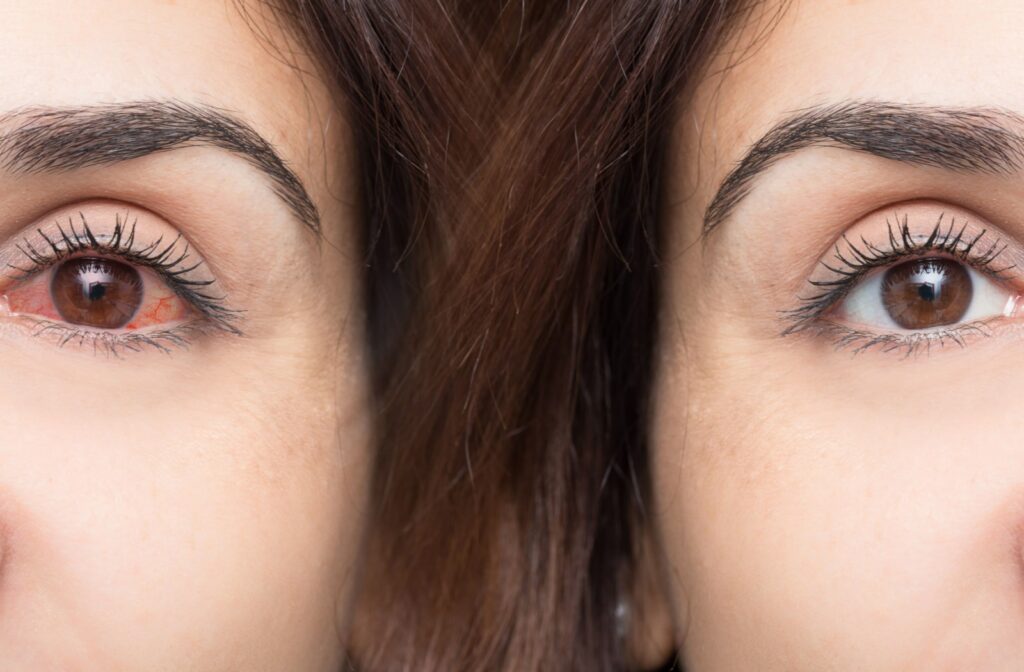Dry eyes can lead to blurry vision, irritation, and discomfort. The cause of your dry eyes can result from various reasons. One type of dry eye is evaporative dry eye, an eye condition affecting the lipid layer of tears, leading to increased tear evaporation.
Your eye doctor can determine the underlying cause of your dry eyes by discussing your symptoms and conducting tests during an eye exam.
What Is Dry Eye Syndrome?
Dry eye syndrome is a common condition characterized by insufficient tears on the eye’s surface. Your eyes depend on a complex tear film to maintain comfort, clarity of vision, and protection against irritants.
The tear film consists of three layers: an oily layer, a watery layer, and a mucus layer. Dry eye syndrome can occur with an imbalance in the composition or production of these tears.
Evaporative Dry Eye
Evaporative dry eye predominantly affects the outermost layer of the tear film—the lipid layer. The lipid layer, comprised of oils, acts as a protective barrier, preventing rapid evaporation of tears and ensuring a smooth, nourishing flow over the eye’s surface.
In evaporative dry eye, there’s an imbalance in the composition of your natural tears, where tears evaporate more quickly, leading to dry eyes.
Cause of Evaporative Dry Eye
The main cause of evaporative dry eye is dysfunction of your meibomian glands, small glands in your upper and lower eyelids that produce oil or meibum found in tears. The meibomian glands can become blocked or inflamed, leading to a decrease in the production of oil.
Blockage of the meibomian glands can result from the following:
- Debris accumulation: Blinking helps wash away germs, dirt, and other debris from the eyes and on the eyelids. Infrequent blinking can lead to fewer tears and an increased risk of clogged glands.
- Skin conditions: Ocular rosacea, face dermatitis, and psoriasis are some conditions that can cause blockages in the glands.
- Allergies: Irritation or inflammation from allergies may cause gland blockage.
- Medications: Antihistamines and decongestants can increase the risk of blockages in the meibomian glands.
- Eye injury: An injury to the eyelids may interfere with oil production.
- Contact lenses: Long periods of contact lens wear without proper cleaning may irritate the glands and reduce tear production.
- Medical conditions: Blockages in the eyelid glands are more common in Sjögren’s disease, rheumatoid arthritis, and diabetes.
Evaporative Dry Eye Symptoms
The symptoms of evaporative dry eye can vary from mild to severe and can include:
- Irritation
- Stinging or burning sensation
- Eye fatigue
- Grittiness
- Blurred vision
- Crusting
- Difficulty wearing contact lenses
- Swollen eyes
Diagnosing Evaporative Dry Eye
Your eye doctor can distinguish and diagnose evaporative dry eye from aqueous deficiency dry eye by looking at your history, symptoms, and lifestyle and doing the following tests:
- Tear break-up time: Measures how quickly your tears evaporate.
- Tear osmolarity test: Measures the water quality in your tear film.
Treatment for Evaporative Dry Eye
Treatment for evaporative dry eye depends on the severity of your symptoms and the underlying cause. Your eye doctor may recommend the following:
- Warm compresses to break up blockages in the meibomian glands.
- Eye washing and gentle massages to the eyelid to help the glands produce more oil.
- Eye drops or artificial tears to temporarily restore lubrication to the eyes. Speak to your eye doctor about which over-the-counter artificial tears to use.
- Medicated drops may help in more severe cases to unblock the glands and provide symptom relief.
- Lipiflow: Uses gentle heat to unblock any clogged glands and restore oil production in tears.
- OptiLight: Uses pulsed light to reduce inflammation, improve tear break-up time, and increase meibomian gland functionality.
- Surgery: In rare cases, your eye doctor may recommend surgical punctal plugs or other surgical approaches necessary to unblock the glands so that they can release oil again.
How to Prevent Evaporative Dry Eye
You can take the following measures to prevent evaporative dry eye and accompanying dry eye symptoms:
- Take regular breaks when using digital devices or reading for long periods, as they can affect your blink rate.
- Practice good eyelid hygiene to remove lid debris and enhance meibomian gland function.
- Avoid smoky environments, as they can irritate the eyes and reduce tear production.
- Drink enough water to maintain eye health and hydration.
- Remove and clean contact lenses regularly to prevent dirt and debris buildup.
Dry Eye Treatment for Vision Comfort
Evaporative dry eye is a common and treatable condition that can affect many people throughout their lifetime. By understanding its causes, symptoms, and treatment options, you can take steps to manage your symptoms and improve your overall eye health.
If you have concerns about your eyes or experience any of the symptoms listed above, book an appointment with the Dry Eye Treatment Center of Connecticut at Higgins Brothers’ Vision Care. Our eye doctors are here to examine your eyes and create a personalized treatment plan for vision health and comfort.




